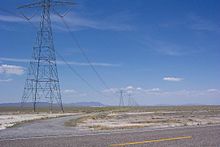| Path 27 | |
|---|---|
 Path 27 as seen on U.S. Route 50 in Utah. An AC transmission line has since been built alongside this segment of the HVDC line. | |
| Location | |
| Country | United States |
| State | Utah, Nevada, California |
| General direction | Southwest |
| From | Intermountain Power Plant near Delta, UT 39°30′27″N 112°34′49″W / 39.50750°N 112.58028°W |
| Passes through | Southern Nevada |
| To | Adelanto Converter Station in Adelanto, CA 34°33′4″N 117°26′14″W / 34.55111°N 117.43722°W |
| Ownership information | |
| Owner | Intermountain Power Agency (IPA) |
| Operator | IPA |
| Construction information | |
| Manufacturer of substations | Asea,[a] ABB Group (2011 upgrade) |
| Construction started | May 1, 1984 |
| Construction cost | $1.1 billion[1] |
| Commissioned | September 16, 1985[1] |
| Technical information | |
| Type | overhead transmission line |
| Type of current | high-voltage direct current |
| Total length | 488 mi (785 km) |
| Power rating | 2,400 MW[2] |
| DC voltage | ±500 kV[b] |
| No. of poles | 2 |
| No. of circuits | 1 |
| Website | https://www.ipautah.com/ |
Path 27, also called the Intermountain[c] or the Southern Transmission System (STS),[4][5][6] is a high-voltage direct current (HVDC) electrical transmission line running from the coal-fired Intermountain Power Plant near Delta, Utah, to the Adelanto Converter Station at Adelanto, California, in the Southwestern United States. It was installed by Asea, a company based in Sweden, and commercialized in July 1986. The system is designed to carry power generated at the power plant in Utah to areas throughout Southern California. It is owned and operated by the Intermountain Power Agency, a cooperative consisting of six Los Angeles-area cities, the largest member being the Los Angeles Department of Water and Power (LADWP), and 29 smaller Utah municipalities.[7][8]
Path 27 consists of an overhead power line 488 miles (785 km) long,[d] and is capable of transferring up to 2,400 megawatts (MW) of power at ±500 kilovolts (kV),[b][e] higher than the power plant's operational output of 1,900 MW. The resulting maximum current is 4,800 amperes.[f] Given its length, a direct current (DC) is preferred to the more common alternating current (AC) as it allows the electrical energy to travel farther with minimal loss to resistance and requires no intermediate stations. It is bipolar, meaning that it has two conductors of opposite polarity (in place of three conductors for AC lines). Both conductors for the entire length are three cables bundled together; this is done to reduce the effects of EM interference and enhance the power line's performance. At each end of the line is a converter station that changes AC to DC on one side and back again on the other. Each terminus also features a dedicated ground which is connected by an electrode line to a grounding site away from the converters to provide ample earth return; this helps protect the main line and equipment from faults, and allows the system to operate at partial capacity.
Sections of Path 27 are paralleled by other AC transmission lines, including some of 500 kV. The powerline is also visible from the Interstate 15 which it passes over multiple times.[10]: 14, ch. 9 The HVDC line's converter stations will be replaced as part of a project to repurpose the Intermountain Power Plant as a hydrogen-burning facility. The stations are expected to go online by June 2026.
Cite error: There are <ref group=lower-alpha> tags or {{efn}} templates on this page, but the references will not show without a {{reflist|group=lower-alpha}} template or {{notelist}} template (see the help page).
- ^ a b "Construction of the Intermountain Power Project's 490-mile transmission line..." UPI. September 17, 1985. Retrieved 2023-01-04.
- ^ "Intermountain Power Project; Case Study". Hitachi Energy. Retrieved December 14, 2022.
- ^ "WECC Path Reports" (PDF). WECC. Retrieved 5 July 2023.
- ^ Beshir, Mohammed J.; Bjorklund, Hans (2012). "Upgrading the Intermountain HVDC Project to handle 480 MW additional Wind Power". ABB Library. Cigre. Retrieved December 14, 2022.
- ^ "Early Power Generation". Water and Power AssociatesEarly Power Generation. December 9, 2022. Retrieved 2022-12-09.
- ^ "Southern Transmission System Project". Southern California Public Power Authority. Retrieved 28 December 2022.
- ^ Roth, Sammy (2019-07-11). "Los Angeles is finally ditching coal — and replacing it with another polluting fuel". Los Angeles Times. Retrieved 2020-08-19.
Utah's Intermountain Power Agency owns the coal plant and the power line, known as the Southern Transmission System.
- ^ "Participants & Service Areas". Intermountain Power Agency. Archived from the original on 2020-08-03. Retrieved 2020-08-19.
- ^ Csanyi, Edvard (August 20, 2014). "The choice of system voltage according to ANSI standard C84.1". Electrical Engineering Portal. Retrieved 26 November 2022.
- ^ Intermountain Power Project Environmental Statement (Report). Bureau of Land Management. 1979.